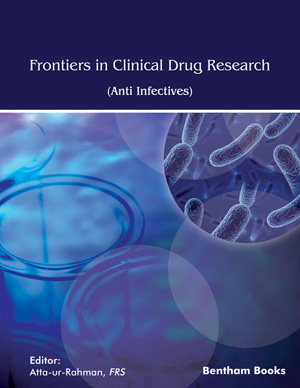Abstract
Toxoplasmosis is caused by an obligate intracellular parasite, Toxoplasma gondii (T. gondii) which infects about thirty percent of the world human population. Infection occurs by the consumption of Toxoplasma tissue cysts in raw or undercooked infected meat, intake of the contaminated food or water with Toxoplasma oocysts shed in the feces of an infected cat, blood transfusion, placental transmission or organ transplantation. Toxoplasmosis is the most common opportunistic infection in the pregnant women and the immunocompromised individuals resulting in severe complications as encephalitis, pneumonitis and myocarditis with high mortalities. Unfortunately, few effective drug therapies for this disease are available, their aim being the decrease of the parasite replication rate to prevent more pathological changes in organs involved as well as to avoid the serious complications. The recommended therapy for treatment or prophylaxis of toxoplasmosis is the combination of pyrimethamine and sulfadiazine, in spite of this combination is so effective against acute toxoplasmosis but being unsuccessful in the treatment of toxoplasmic chorioretinitis, encephalitis, and congenital toxoplasmosis. Anti-Toxoplasmic drugs need to be effective against the all stages and strains of Toxoplasma parasite with a higher penetration into the cerebral, ocular and placental tissues and have no side effects as fetal toxicity and teratogenic effects. Up till now, there is no available drug has all these advantages. The occurrence of side effects, the development of resistant strains and the lack of effectiveness against Toxoplasma tissue cyst are the main disadvantages of the current drug therapies. The discovery of drug therapies with a lower toxicity and able to prevent and treat toxoplasmosis would represent a novel era in the treatment of this infectious disease, especially in immunosuppressed patients. Therefore, the researches technology with regard to the parasite’s proteomics and functional genomics are needed for the development of new and safer drug agents. Currently, an increase orientation of the pharmacological action of natural agents and medicinal plants are usually considered to be safer than synthetic drugs. The value of these plants as sources of natural product bioactive molecules to medicine related to their chemotherapeutic effect and considered as template molecules for the manufacture of new drug agents. Recently, most of the researches in the drug development for toxoplasmosis focus on the use of nanotechnology for improving the pharmacokinetic profile of drugs. The combination of nanoparticles and plant extracts to give rise broad spectrum of drugs may be a greater chance for defeating Toxoplasma infection. This chapter aimed at giving an update on the current progress in the development of new drugs for the treatment of toxoplasmosis.
Keywords: Current therapeutics, Medicinal plants, Nanotechnology, Toxoplasma gondii, Treatment.






















